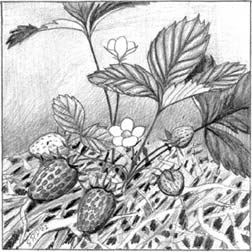|
|
 In Season: Strawberries in the Patch In Season: Strawberries in the Patch
by Gary Pendleton
We moved into our house in North Beach on Memorial Day weekend in 1997. At first, we really missed our old neighborhood. We had friends there, and it was a nice place to live. One of the things we left behind was our strawberry patch, which we sorely missed that time of year.
A couple of years before the move, I had planted some Tristar Strawberry plants. Tristars are ever-bearers, producing a crop from late May to September. In contrast, the typical plant is a June-bearer producing one bumper crop and that’s all.
Adding to our homesickness was missing our daily summertime ration of fresh, flavorful strawberries. It was too late in the year to put in a patch of plants at our new home, so we had to wait out a year.
There is no comparison, none at all, between the flavor of a typical store-bought strawberry and a homegrown or locally grown strawberry. Commercially grown varieties are obviously bred for their durability and shelf life, not for flavor.
The following winter, when I received my seed and nursery catalogues in the mail, I found a source for Tristars and ordered them for spring delivery. April came and the nursery sent me asparagus. I called the 800 number. “No problem, our mistake, keep the asparagus, we’ll send the strawberries.” In a few days a second package arrived containing more asparagus. My Tristars finally did arrive. I donated the asparagus to the South County Community Farm and planted the berries in a raised bed behind the house.
Over the years I’ve learned a few things about how to take care of the plants and increase production. At the end of the growing season, cut back the leaves and stems and mulch heavily with straw. In spring, I fertilize with about an inch of compost, and in the growing season I give them plenty of water. I pick ripe berries in the evening, so slugs won’t eat them overnight.
The patch produces just about enough for two people and I don’t know how many slugs, so there is not a lot of excess produce to share. But if you happen to be a visitor to the back yard you may pick a few. Once, when I was out picking, I stopped to chat with my neighbor over the back fence and I offered him a berry. He accepted somewhat nonchalantly but when he tasted, his expression changed radically and he emitted a sincere “Wow!” He must have gotten one that was at its peak. I guess that he had not tasted a real strawberry in many years.
Gardening books advise removing and replacing old plants with young every few years. But last spring there was a burst of productivity that suggested the plants had plenty of life in them. Our patch is in its fifth year, old for a strawberry patch. Judging by looks, I think this patch is past its prime. Maybe with more compost, plenty of water and some diligent slug hunting, we’ll make it to Labor Day.
Copyright 2002
Bay Weekly
|